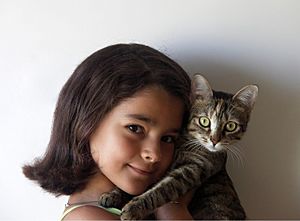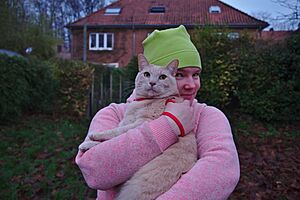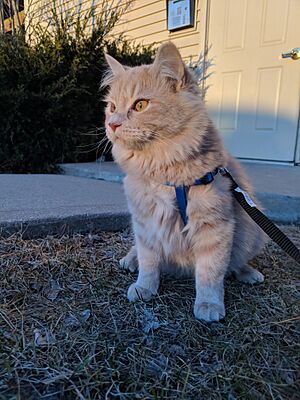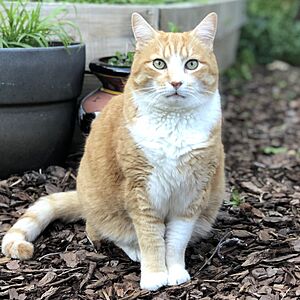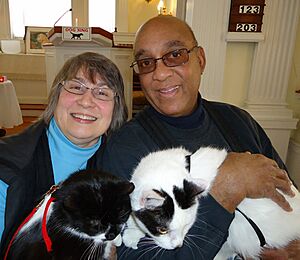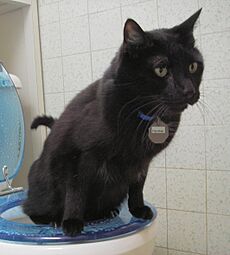Human interaction with cats facts for kids
Humans and cats have a special connection! Hundreds of millions of cats around the world live as pets. This relationship involves being friends, communicating with each other, and taking care of one another. For thousands of years, cats were first kept to help control pests like mice. Later, they became loved companions. Cats talk to us using sounds, body language, and actions. They form strong bonds with their human families. As pet owners, we give them food, a safe home, and medical care. Playing and fun activities help cats stay healthy and happy, both physically and mentally. Even though cats can be quite independent, they enjoy being with humans. It's important to understand their unique behaviors. Using positive training methods can help teach cats good habits, creating a happy relationship between humans and their furry friends, built on respect and love.
Contents
Cats as Pets
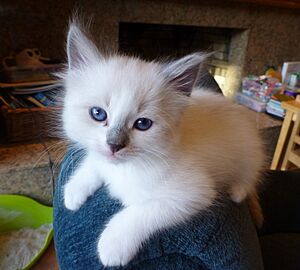
Cats are very popular pets all over the world where people live. It's hard to know exactly how many there are, but estimates suggest there are between 200 million and 600 million cats globally.
In 1998, there were about 76 million cats in Europe, 7 million in Japan, and 3 million in Australia. By 2007, a report showed that about 37 million homes in the United States had cats. Each home had about 2.2 cats, making a total of around 82 million cats. This was more than the 72 million pet dogs in the US at that time. Cats became more numerous than dogs in the United States for the first time in 1985. This happened partly because cat litter was invented in the mid-1900s, which helped control the strong smell of cat urine.
A survey in 2007 found that men and women in the US were equally likely to own a cat. The number of purebred cats compared to mixed-breed cats changes from country to country. However, usually, less than 10% of all cats are purebred.
As of 2021, in the United States, most cat owners keep their cats indoors all the time. In rural areas, cats often live outside and help keep away rodents, snakes, and other pests. In the United Kingdom, most cats go outside sometimes, with 26% staying indoors all the time.
Sometimes, people keep a very large number of cats. This is sometimes linked to the idea of "cat ladies," but there's no proof that older women are more likely to do this than anyone else.
Cat Fur Use
Besides being pets, cats have also been used in the international fur trade. Cat fur was used to make coats, gloves, hats, shoes, blankets, and stuffed toys. It took about 24 cats to make one cat fur coat. This practice is now against the law in many countries, including the United States, Australia, and countries in the European Union. However, even though it's illegal, some cat furs are still made into blankets in Switzerland. People there believe these blankets can help with rheumatism as a traditional remedy.
Cats for Pest Control

Cats are also used to control pests, especially when there are too many rats or mice. This is why they are sometimes called "mousers." For example, in the United Kingdom, there has been a cat at 10 Downing Street (the Prime Minister's home) since the 1500s. This cat is officially called the 'Chief Mouser to the Cabinet Office' since 2011. Its other jobs include greeting guests, checking security, and testing old furniture for napping comfort!
Different Types of Domestic Cats
There are many different cat breeds. The US Cat Fanciers' Association recognizes 41 breeds. Sixteen of these are "natural breeds," meaning they probably existed before humans started breeding specific types of cats. The other breeds were developed in the second half of the 1900s. Because cats often mix breeds, many are simply called domestic longhair or domestic shorthair, depending on their fur length.
How Cats Affect Human Health
Because house cats are small, they usually don't pose a big physical danger to adult humans. However, in the US, cat bites lead to about 400,000 emergency room visits each year. At least 10% of these bites are from cats that were not provoked. This number is about one out of every ten animal bites. Cat bites can get infected, sometimes with serious results like rabies, though this is very rare.
Cats can also pose a risk to pregnant women and people with weakened immune systems. In rare cases, their waste can spread toxoplasmosis. A large number of cats are infected with this parasite, with infection rates ranging from about 40% to 60% in both pet and stray cats worldwide.
Allergic reactions to cats are quite common, affecting as many as 3 out of 10 Americans. The main substance that causes allergies, called Fel d 1, is found in the saliva and/or dander (tiny flakes of skin) of all cat breeds. There have been attempts to breed hypoallergenic cats, which would be less likely to cause an allergic reaction. Some people who are allergic to cats (showing symptoms like hay fever, asthma, or a skin rash) can get used to a specific cat and live comfortably with it, even if they are still allergic to cats in general. It's not clear if owning a cat increases or decreases the risk of developing allergic diseases like asthma. Some owners manage their allergies by taking medicine and bathing their cats often, as weekly bathing can reduce the amount of dander a cat sheds.
Besides possible health risks, spending time with cats can improve health and reduce stress. For example, being around cats might slightly lower blood pressure. Owning a cat can also improve mental well-being by offering emotional support and helping with feelings of sadness, worry, and loneliness. Their ability to provide companionship and friendship is a common reason why people own cats.
Cats are also thought to improve their owners' general mood by making negative feelings go away. A Swiss study in 2003 suggested that cats might change their owner's overall mental state, as their company seems to be similar to that of a human partner. The researchers found that while cats didn't necessarily create positive moods, they did help reduce negative ones.
One study found that owning a cat was linked to a lower risk of heart attacks and strokes.
Several studies have shown that cats develop affection for their owners. However, how much pets affect human health depends a lot on the time and effort the cat owner puts into bonding and playing with their cat.
Ailurophobia is a rare animal phobia where humans have a strong and extreme fear or hatred of cats. The exact cause of ailurophobia is not known, and treatment usually involves therapy.
Therapy Cats
Some cats, called "therapy cats," are trained to help sick people in a way that benefits their health. They use the special bond between humans and animals for relaxation and healing. Certain cat breeds are good for therapy work because of their personality. Some examples of popular breeds are Ragdolls, Maine Coons, American Shorthairs, Siamese, and Persians. The important qualities to look for in a therapy cat include being calm and tolerant of new or sudden sights and sounds, being okay with awkward or rough petting, and staying calm when poked or pulled in unusual ways. Therapy cats must also be used to people of all ages and enjoy interacting with strangers every day. Some therapy cats are used instead of therapy dogs because cats are smaller and calmer, which helps them work with patients who might be scared of dogs. Therapy cats should still be comfortable around dogs, as most visits happen with both.
Having cats around, hearing them purr, and petting them can offer both mental and physical benefits. Therapy cats are used as companions to help people recover and feel better after having strokes, high blood pressure, anxiety, and/or depression, among other things.
Therapy cats are used as companions in places like juvenile detention centers, for children with developmental disabilities, and for children with language, speech, and hearing difficulties. Therapy cats are also sometimes used in hospitals to help children relax while they are staying there. They also help people in hospice care cope with their serious illnesses.
Indoor Scratching Behavior
It's natural for cats to hook their front claws into surfaces and pull backward. Cats, like humans, stretch to keep their muscles strong and their bodies flexible. Also, this scratching helps clean and sharpen their claws. Indoor cats can benefit from having a scratching post. This makes them less likely to use carpets or furniture, which they can easily damage. However, some cats might just ignore a scratching post. Store-bought scratching posts are usually covered in carpet or fabric. Using a plain wooden surface, or turning the carpet on the posts so the rougher back side faces out, might be more appealing to a cat than the floor covering. Scratching posts made of sisal rope or corrugated cardboard are also common.
Even though scratching helps cats keep their claws from getting too long, their nails can be trimmed if needed. Another way to deal with indoor scratching is a surgery called onychectomy, commonly known as declawing. This surgery removes the claw and the first bone of each toe on a cat's paws. Declawing is most often done only on the front feet. A similar surgery is tendonectomy, which involves cutting a tendon that cats need to extend their claws. Declawing is a major surgery and can cause pain and infections.
Cat Waste and Litter Boxes
Cats are very clean animals and naturally bury their urine and feces. House cats are usually given a box containing litter. This litter is often made of bentonite, but sometimes other absorbent materials like shredded paper, wood chips, or even sand can be used. The litter box should be cleaned daily and the litter changed often, depending on how many cats use it and what type of litter it is.
Checking the litter box daily also helps you monitor your cat's health.
Some cats can be trained to use the human toilet. This removes the need for a litter box, which saves money, prevents unpleasant smells, and reduces waste going to landfills.
Treating Cats Like Family
Pet humanization is when cats are kept for companionship and treated more like human family members than traditional pets. This trend means giving cats a higher level of care, attention, and often even luxury, similar to how humans are treated. In this trend, cats are seen, cared for, and valued in a way that mirrors how humans are treated within a family or social group. It involves giving cats human-like qualities, emotions, and needs. It also means giving them care, attention, and comforts similar to those given to human family members. When pets are humanized, cats kept as pets are often seen as beloved family members, not just animals or possessions.
Similarities Between Cats and Humans
Cats and humans share a common ancestor from about 80 million years ago. Since then, they have only had 10–12 changes in their chromosomes. The arrangement of eight genes on a cat's Y chromosome is very similar to that in humans. Genes on the X chromosomes of cats and humans are also arranged in a similar way.
Domestic cats can have over 250 natural genetic disorders. Many of these are similar to human conditions, such as diabetes, hemophilia, and Tay–Sachs disease. For example, the Abyssinian cat breed has a genetic mutation that causes retinitis pigmentosa, a condition that also affects humans. The domestic cat is also a good animal to study for human infectious diseases, including HIV/AIDS. The Feline immunodeficiency virus (FIV) is a genetic relative of HIV.
Images for kids
See also
- Bodega cat
- Cat bite
- Cat café
- Cat lady
- Cat lover culture
- Cat massage
- Cat meat
- Cat show
- Cats and Islam
- Cats by country
- Cats in ancient Egypt
- Farm cat
- Feral cat
- Library cat
- Lolcat
- National Cat Day
- Pet humanization
- Ship's cat
- Zoonosis


